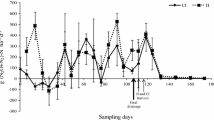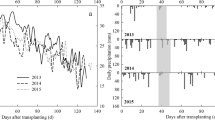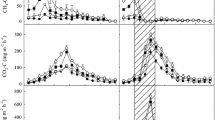Abstract
Although intermittent drainage is regarded as a key factor to reduce methane (CH4) emission from paddy soil during rice cultivation, it also could increase nitrous oxide (N2O) emission. However, the effects of intermittent drainage on CH4 and N2O emissions with different global warming potential (GWP) values have not been well examined. In the present study, the effect of a 26-day intermittent drainage from the 34th day after transplanting (DAT) to the 60th DAT on two greenhouse gas (GHG) fluxes and yield properties were compared with those of a continuous flooding system under different fertilization (NPK as control, PK, and NPK+straw) during rice cultivation. The effect of intermittent drainage on changing two GHG emissions was compared using the GWP value, calculated as CO2 equivalents by multiplying 25 and 298 to the seasonal CH4 and N2O fluxes, respectively. Under the same irrigation condition, addition of nitrogen to PK significantly increased seasonal CH4 and N2O fluxes, and addition of straw to NPK increased CH4 and N2O. Irrespective with fertilization background, the intermittent drainage significantly reduced the total GWP by ca. 41–70% as affected by the big reduction of seasonal CH4 fluxes by ca. 43–53% to that of the continuous flooding even with an increase of seasonal N2O emissions by ca. 16–43%. Rice productivity was not significantly different between the two different irrigation systems under same fertilization background. As a result, total GWP per grain yield was significantly lower in all fertilization treatments with intermittent drainage compared with continuous flooding.
Similar content being viewed by others
References
Alberto MCR, Arah JRM, Neue HU, Wassmann R, Lantin RS, and Aduna JB (2000) A sampling technique for the determination of dissolved methane in soil solution. Chemosphere: Global Change Science 2, 57–63.
Allison LE (1965) Organic carbon. In Methods of Soil Analysis, Part 2, Black CA, Ensmanger LE, and Clark FE (eds.), pp. 1367–1376, American Society of Agronomy, USA.
Anastasic C, Dowding M, and Simpson VJ (1992) Future CH4 emissions from rice production. J Geophys Res 97, 7521–7525.
Azam F, Lodhi A, and Ashraf M (1991) Availability of soil and fertilizer nitrogen to wetland rice following wheat straw amendment. Biol Fertil Soils 11, 97–100.
Buendia LV, Neue HU, Wassmann R, Lantin S, and Javellana AM (1997) Understanding the nature of methane emission from rice ecosystem as basis mitigation strategies. Appl Energy 56, 433–444.
Butterbach-Bahl K, Gasche R, Breuer L, and Papen H (1997) Fluxes of NO and N2O from temperate forest type, N deposition and of liming on the NO and N2O emissions. Nutr Cycl Agroecosyst 48, 79–90.
Cai ZC (1997) A category for estimation of CH4 emission from rice paddy fields in China. Nutr Cycl Agroecosyst 49, 171–179
Cai ZC, Xing GX, Yan XY, Xu H, Tsuruta H, Yagi K et al. (1997) Methane and nitrous oxide emissions from rice paddy fields as affected by nitrogen fertilizers and water management, Plant Soil 196, 7–14.
Granli T and Bøockman OC (1994) Nitrous oxide from agriculture. Norw J Agric Sci (Suppl), 12, 7–128.
Hua X, Guangxi X, Cai ZC, and Tsuruta H (1997) Nitrous oxide emissions from three rice paddy fields in China. Nutr Cycl Agroecosyst 49, 23–28.
IPCC (2007) Climate Change 2007: The physical science basis. In Contribution of Working Group I to the Fourth Assessment Report of the Intergovernmental Panel on Climate Change, Solomon, S Qin D, Manning M, Chen Z, Marquis M, Averyt KB et al. (eds.), Cambridge University Press, USA.
IRRI (1989) IRRI Toward 2000 and Beyond. International Rice Research Institute, Philippines.
Kanno T, Miura Y, Tsuruta H, and Minami K (1997) Methane emission form rice paddy fields in all of Japanese prefecture. Nutr Cycl Agroecosyst 49, 147–151.
Kim SY, Gutierrez J, and Kim PJ (2012) Considering winter cover crop selection as green manure to control methane emission during rice cultivation in paddy soil. Agric Ecosyst Environ 161, 130–136
Kimura M (1992) Methane emission from paddy soils in Japan and Thailand. In World Inventory of Soil Emission Potentials, Batgates NH and Bridges EM (eds.), pp. 43–79, ISRIC, Netherlands.
Mae T (1997) Physiological nitrogen efficiency in rice: nitrogen utilisation, photosynthesis and yield potential. Plant Soil 196, 201–210.
Masscheleyn PH, DeLaune RD, and Patrick WH Jr (1993) Methane and nitrous oxide emissions from laboratory measurements of rice soil suspension: Effect of soil oxidation-reduction status. Chemosphere 26, 251–260.
Minamikawa K, Sakai N, and Yagi K (2006) Methane emission from paddy fields and its mitigation options on a field scale. Microbes Environ 21, 135–147.
Minoda Y and Kimura M (1994) Contribution of photosynthesized carbon to the methane emitted from paddy fields. Geophy Res Lett 21, 2007–2010.
Neue HU and Sass RL (1994) Trace gas emission from rice fields. IG Activities 17, 3–11.
Neue HU, Wassmann R, Lantin RS, Alberto MACR, Aduna JB, and Javellana AM (1996) Factors affecting methane emission from rice fields. Atmos Environ 30, 1751–1754.
Nishimura S, Sawamoto T, Akiyama H, Sudo S, and Yagi K (2004) Methane and nitrous oxide emissions from a paddy field with Japanese conventional water management and fertilizer application. Global Biogeochem Cycl 18. 10.1029/2003GB002207
Ponnamperuma FN (1972) The chemistry of submerged soil. Adv Agron 24, 29–95.
Rao DN and Mikkelsen DS (1976) Effect of rice straw incorporation on rice plant growth and nutrition. Agron J 68, 752–755.
RDA (1988) Method of Soil Chemical Analysis. National Institute of Agricultural Science and Technology. Rural Development Administration, Korea.
RDA (1995) Standard Investigation Methods for Agriculture Experiment. Rural Development Administration, Korea.
Robertson GP, Paul EA, and Harwood RR (2000) Greenhouse gases in intensive agriculture: contributions of individual gases to the radiative forcing of the atmosphere. Science 289, 1922–1925.
Rolston DE (1986) Gas flux. In Methods of Soil Analysis, Part I: Physical and Mineralogical Methods, Klute A (ed.), Am Soc Agron, USA.
SAS Institute (2003) System for Windows Release 9.1. SAS Institute, USA.
Schütz H, Holzapfel-Pschom A, Conrad H, Rennenberg H, and Seiler W (1989) A 3-year continuous record on the influence of daytime, season, and fertilizer treatment on methane emission rates from an Italian rice paddy. Geophys Res 94, 16045–16416.
Shiratori Y, Watanabe H, Furukawa Y, Tsuruta H, and Inubushi K (2007) Effectiveness of a subsurface drainage system in poorly drained paddy fields on reduction of methane emissions. Soil Sci Plant Nutr 53, 387–400.
Sinha SK (1995) Global methane emission from rice paddies: Excellent methodology but poor extrapolation. Curr Sci 68, 643–646.
Singh S, Singh JS, and Kashyap AK (1999) Methane flux from irrigated rice fields in relation to crop growth and N fertilization. Soil Biol Biochem 31, 1219–1228.
Verma TS and Bhagat RM (1992) Impact of rice straw management practices on yield, nitrogen uptake and soil properties in a wheat-rice rotation in northern India. Fertil Res 33, 97–106.
Wang Z, Delaune RD, Lindau C, and Patrick WH Jr (1992) Methane production from anaerobic soil amended with rice straw and nitrogen fertilizers. Fertil Res 33, 115–121.
Wang ZP, Delaune RD, Masscheleyn PH, and Patrick WH (1993) Soil redox and pH effects on methane production in a flooded rice soil. Soil Sci Soc Am J 57, 382–385.
Wassmann R and Aulakh MS (2000) The role of rice plants in regulating the mechanism of methane emission. Biol Fertil Soils 31, 20–29.
Wassmann R, Papen H, and Rennenberg H (1993) Methane emission from rice paddies and possible mitigation strategies. Chemosphere 26, 201–217.
Watanabe A, Satoh Y, and Kimura M (1995) Estimation of the increase in CH4 emission from paddy soils by rice straw application. Plant Soil 173, 225–231.
Xiong ZQ, Xing GX, and Zhu ZL (2007) Nitrous oxide and methane emissions as affected by water, soil and nitrogen. Pedosphere 17, 146–155.
Yagi K (1997) Methane emission from paddy soils. Bull Natl Inst Agro-Environ Sci 14, 96–210.
Yagi K, Tsuruta H, Kanda K, and Minami K (1996) Effect of water management on methane emission from a Japanese rice paddy field: Automated methane monitoring. Glob Biogeochem Cycle 10, 255–267.
Yan XY, Shi SL, Du LJ, and Xing G (2000) Pathways of N2O emission from rice paddy soil. Soil Biol Biochem 32, 437–440.
Zhang H, Zhang S, Zhang J, Yang J, and Wang Z (2008) Post-anthesis moderate wetting drying improves both quality and quantity of rice yield. Agron J 100, 726–734.
Zou JW, Huang Y, Jiang JY, Zheng XH, and Sass RL (2005) A 3 year field measurement of methane and nitrous oxide emissions from rice paddies in China: effects of water regime, crop residue, and fertilizer application. Global Biogeochem Cycles 19, GB2021.
Author information
Authors and Affiliations
Corresponding author
Rights and permissions
About this article
Cite this article
Kim, GY., Gutierrez, J., Jeong, HC. et al. Effect of intermittent drainage on methane and nitrous oxide emissions under different fertilization in a temperate paddy soil during rice cultivation. J Korean Soc Appl Biol Chem 57, 229–236 (2014). https://doi.org/10.1007/s13765-013-4298-8
Received:
Accepted:
Published:
Issue Date:
DOI: https://doi.org/10.1007/s13765-013-4298-8




